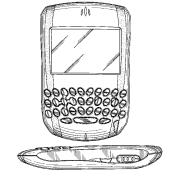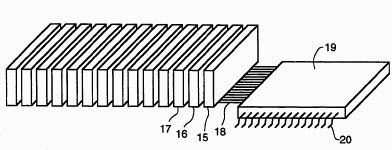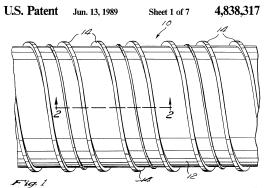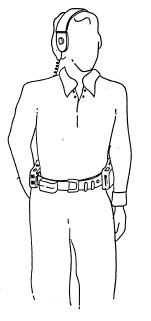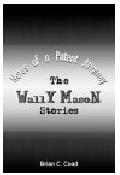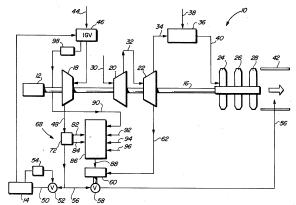Stephen Nipper has discovered another great resource for those interested in up-to-date news about intellectual property issues: IP NewsFlash.
June 2004
Nokia – NTP settle over BlackBerry Patent Infringement
ZD Net is reporting that Nokia has obtained a licensing agreement from NTP for use of patents that allegedly cover RIM’s BlackBerry device. BlackBerry enabled Nokia devices should be available in the U.S. “in two to three months.”
The patent infringement case between RIM and NTP is ongoing. The Federal Circuit recently heard oral arguments in an appeal of the district court’s patent infringement finding. A ruling is expected within the next several weeks. Read more about the lawsuit here.
Although the terms of the agreement have not been made public, the license gives Nokia two big advantages. First, it allows Nokia to hedge its bets against the outcome of the RIM lawsuit. Second, and perhaps more important, Nokia is setting itself up to get a “first-mover” advantage over other carriers.
“There is a reasonable likelihood that they might not get all the patents thrown out,” said patent lawyer Brad Hulbert of McDonnell, Boehnen, Hulbert & Berghoff LLP in Chicago. “It’s better to pay now than pay more later.” (Bloomberg)
(Drawing is from RIM’s U.S. Design Patent D479,233).
Patent Marking and Infringement Damages
A common patent question is whether products should be marked with any relevant patent number. The simple answer is that marking provides “constructive notice” to infringers and may allow a patentee to collect greater damages in an infringement suit.
According to the marking statute:
In the event of failure so to mark, no damages shall be recovered by the patentee in any action for infringement, except on proof that the infringer was notified of the infringement and continued to infringe thereafter, in which event damages may be recovered only for infringement occurring after such notice.
35 U.S.C. 287(a). As an added bonus, patent marking plates are becoming popular collectables.
Electronic Filing Software
LegalStar is offering its electronic patent filing software free until Labor Day 2004 (normally $50 per filing). I have not used their software yet, but am planning to try soon. The USPTO also offers EFS software here.
There are two reasons why I am convinced that electronic filing will be standard operating procedure for the majority of new filings within the next 18 months. First, it is likely that electronically filed applications will be given a hefty discount on filing fees. Second, attorneys will appreciate the peace of mind that comes with the immediate confirmation of filing.
It is difficult to predict whether practitioners will end up using USPTO’s filing software or that of a company like LegalStar. Any software company will need a compelling argument to show that its software is better than the USPTO’s free version. In the long run, electronic filing software will likely be tied to prosecution docketing programs and sold as a bundle.
Read the USPTO’s memo on the legal framework for electronic filing.
In Re Jack Richard Simpson
In Re Jack Richard Simpson (Fed. Cir. June 9, 2004) (not citable as precedent).
In an appeal from the Board of Patent Appeals and Interferences (“Board”) for a pending patent application, the Court affirmed the Board’s rejection of Simpson’s claims as anticipated by U.S. Patent 5,161,442 under 35 U.S.C. 102(b). (The application involved technology for cutting cardboard.) Although not explicitly described in the prior art, the Court found anticipation because the reference was “inherently ‘capable’ of performing the functions claimed by Simpson.”
University of California v. Actagro (Preliminary Injunction Vacated)
The Regents of the University of California and Biagro Western Sales, Inc v. Actagro, LLC (Fed. Cir. June 9, 2004) (not citable as precedent).
In an infringement suit involving phosphorous fertilizer, the Federal Circuit panel vacated a preliminary injunction against Defendant Actagro because Actagro raised “a substantial question as to the validity of the ‘200 patent.” (U.S. Patent 5,514,200).
Given the evidence offered by Actagro, which on its face suggests that the SSP reference is a concentrated phosphorus fertilizer as contemplated by the claims, we find that Actagro has raised a substantial question as to the validity of the ‘200 patent. For that reason, we must conclude that the first prerequisite for entry of a preliminary injunction is lacking.
Patent Busting Contest
In their first Patent Busting Contest, the Electronic Frontier Foundation (EFF) is “seeking nominations for ten patents that deserve to be revoked because they are invalid.”
In order to qualify for our ten most-wanted list, a patent must be software or Internet-related and there must be a good reason to suspect that the patent claims are invalid. We’re especially interested in patents that target tools of free expression, such as streaming media, blogging tools, and voice over IP (VoIP) technology. Most importantly, the patent-holder must be aggressively enforcing its patent and suing (or threatening to sue) alleged infringers. We’re particularly interested in cases where the patent-holder is trying to force small businesses, individuals, nonprofits, and consumers to pay licensing fees. Deadline to enter is June 23.
The 10 best (worst) patents will be selected for reexamination proceedings
Links:
EFF Press Release
Inter partes reexamination rules
Nonobviousness
IPCentral has an ongoing discussion of the nonobviousness requirement of patentability. They quote one of my favorite law school professors (John Duffy).
[T]he Supreme Court … has not heard a case involving the nonobviousness doctrine in more than a quarter century. I recently gave a presentation at a patent reform conference in which I gave reasons why this drought may end very soon. Many people are not satisfied with the state of the law concerning nonobviousness.
Specifically, many are arguing that nonobviousness is taken much too lightly by the Federal Circuit.
Watson v. H.J. Heinz Co.
Richard Watson v. H.J. Heinz Co. (Fed. Cir. June 8, 2004) (nonprecedential opinion)
In this trade secret case, the appellate panel held that Watson had no legal standing to sue Heinz for allegedly stealing his “trap cap” design for squeeze bottles of ketchup. Watson had filed for bankruptcy and not listed any trade secrets as assets. The court found that any property rights in the trade secret passed to the bankruptcy estate and no longer belong to Watson.
Animatics v. Quicksilver Controls
Animatics Corp. v. Quicksilver Controls, Inc. and Donald P. Labriola II (Fed. Cir. June 8, 2004) (nonprecedential opinion)
After a hung jury could not decide the issue of infringement, the judge granted a JMOL of infringement as to some claims and noninfringement/invalidity as to others. The Federal Circuit affirmed in part, vacated in part, and remanded for further findings.
We agree with Quicksilver’s contention that the district court’s reliance on claim differentiation was legal error. Claim differentiation is a judicial doctrine that cannot be used to override statute.
Shimano v. SRAM
Shimano has requested an inter partes examination of SRAM’s patent 6,520,297, Title: Cable feed for a mechanical ball bearing disc brake.
Metabolite Labs. v. LabCorp
Metabolite Laboratories, Inc. and Competitive Technologies, Inc. v. Laboratory Corporation of America Holdings (doing business as LabCorp) (Fed. Cir. June 8, 2004)
The Federal Circuit (J. Rader) affirmed the jury verdict of indirect infringement and breach of contract, and affirmed the district court’s award of over $8 million in damages to Metabolite (including damages for willfulness).
As expected, the appellate court ruled that the same claim construction should be used for damage calculations as is used for infringement and validity analysis.
This court declines the invitation to apply a different claim construction for computation of damages than for infringement liability.
Additionally, the court refused to vacate the willfullness damages even though the district court did not examine any of the Read factors in its decision.
That the district court did not explicitly set forth its rationale for awarding Metabolite enhanced damages based on LabCorp’s willful indirect infringement is not fatal to its decision…. The district court’s failure to discuss the Read factors, although contrary to this court’s strong preference for the enumerated bases underlying its decision, in this case was at most harmless error.
Finally, the Appellate Panel held that no justification for a permanent injunction is required once infringement is found.
[T]he district court properly granted the injunction because LabCorp was found to infringe. See W.L. Gore & Assocs., Inc. v. Garlock, Inc., 842 F.2d 1275, 1281 (Fed. Cir. 1988) (“[A]n injunction should issue once infringement has been established unless there is a sufficient reason for denying it.”).
Holiday Matinee v. Rambus
Holiday Matinee, Inc. v. Rambus, Inc., No. H026142 (Cal. App. May 27, 2004)
In a consumer class action for alleged anticompetitive conduct in connection with patents on computer memory chip technology, the California State Court held that the complaint was demurrable because the Federal Courts have exclusive jurisdiction over patent matters.
W.E. Hall v. Atlanta Corrugating
W.E. Hall Company, Inc. v. Atlanta Corrugating, LLC (Fed. Cir. June 7, 2004)
In a patent infringement suit, the Federal Circuit affirmed the lower court’s claim construction and noninfringement summary judgment. (U.S. Patent 4,838,317, on a Hydraulically Efficient Ribbed Pipe)
Appellant argued that ambiguity in the written description and prosecution history warranted a special meaning for several contested terms. The court disagreed:
Where, as here, the written description and prosecution history are ambiguous as to whether the patentee used the claim terms inconsistent with their ordinary and customary meanings, it is the ordinary and customary meanings that the terms obtain.
BlackBerry Lawsuit
The CAFC is expected to hear oral arguments today in the patent infringement case against RIM, the maker of the BlackBerry. The district court issued an injunction against RIM and awarded over $50 million in damages to NTP. The injunction was stayed awaiting the results of the appeal.
NTP’s patents are directed toward an “electronic mail system with RF communications to mobile processors.” (e.g., U.S. Patent No. 5,436,960).
NYTimes Article (Free Subscription)
For what it’s worth, RIM’s patent drawings are much more interesting.
Prior Art Citations
A new working paper by Juan Alcacer and Michelle Gittelman (Both at NYU) examines prior art citations in patents. One interesting finding:
On a per patent basis, 2/3 of all cited art was discovered by Examiners rather than submitted by Inventors.
Alcacer, Juan and Gittelman, Michelle, “How do I Know what you Know? Patent Examiners and the Generation of Patent Citations“
Judge Paul Michel
A recent interview with Federal Circuit Judge Paul Michel is published here by Managing Intellectual Property. Excerpt:
Q: What makes a good appeal advocate?
A: The most important quality is selectivity – to select the right issues, the right facts, and the right authorities. The second is to appreciate the power of clarity. It’s startling given the intelligence, industry, knowledge and familiarity with the law of the lawyers that they’re so often unclear.
I would rather have a 10-page brief written by hand on a pad of paper by a really great lawyer than have a 50-page brief by somebody who is mainly throwing dicta at me, which is what the majority of briefs do. I’d rather have the sense that one good legal mind has wrestled the problems of the case until they are pinned to the mat rather than the sense that a committee of mostly younger lawyers have written an enormously long, enormously complicated and often somewhat unclear brief. Clarity and logic can’t be overdone and they are very often, in my opinion, underdone.
Bill Heinze provided the link.
Walkman Inventor May Sue Apple
Washington Times is reporting that the inventor of the portable stereobelt (Andreas Pavel) may sue Apple over its iPod technology. Mr. Pavel holds several patents including US Patent No. 5,201,003. The ‘003 patentissued in 1992, but claims priority to a 1978 application.
Reportedly, Sony recently paid Mr. Pavel several million dollars after a long dispute and settlement negotiation over Walkman technology.
Patent Law Fiction
Brian C. Coad has published his second Wally Mason book. This one titled "Notes of a Patent Attorney: The Wally Mason Stories." According to his Bio, Coad holds about twenty patents, and has published technical papers, poetry, and op-ed pieces for the local newspapers in addition to his fiction.
Honeywell v. Hamilton Sundstrand
Honeywell International, Inc. (formerly known as AlliedSignal Inc.) v. Hamilton Sundstrand Corp. (formerly known as Sundstrand Corp.) (Fed. Cir. June 2, 2004) (en banc)
During prosecution, Honeywell had cancelled its broad independent claim and rewritten dependent claims in independent form. (U.S. Patent No. 4,380,893). The jury found that the patents in suit were valid and, although not literally infringed, infringed under the doctrine of equivalents. The district court entered judgment against Sundstrand.
On appeal, the Court extended Festo in holding “that the rewriting of dependent claims into independent form coupled with the cancellation of the original independent claims creates a presumption of prosecution history estoppel.” The case was remanded for a determination as to whether the patentee can rebut the presumption of surrender under Festo.
In dissent, J. Newman argued that the holding will lead applicants to file more independent claims and fewer dependent claims — thus complicating the job of the patent office.
Hamilton Sundstrand is a United Technologies Corporation (UTC).
